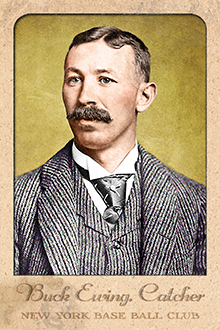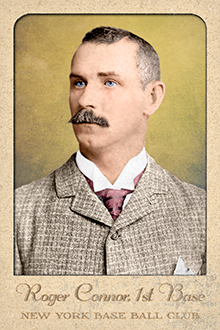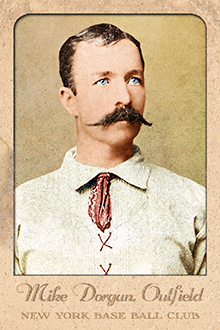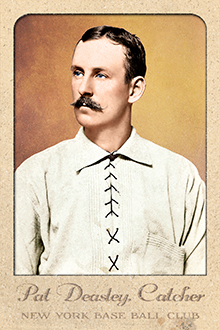
- Series: Pioneer Portraits II: 1875-1899
- City: New York
- Team: Giants
- League: National League
- Hall: National Baseball Hall of Fame
William Ewing (1859-1906) was the premier catcher of the 19th century, honored for decades after his early death as even, perhaps, the greatest player of all time. A scourge at bat, Buck hit over .300 ten times. He played behind the plate with courage and style, crouching close to the hitter so as to shave precious seconds off his inerrant throws. Ewing had debuted with the remarkable Troy Trojans in 1880 and joined four future Hall-of-Famers in moving to NYC in ‘83. The sturdy catcher may have been the primary inspiration for Jim Mutrie’s “my Giants!” exclamation that led to the new identity of the Gothams. An arm injury on a raw spring day curtailed his tenure behind the plate from 1891 on. Such a magnetic figure couldn’t escape the turmoil of the Players’ League controversies and Ewing was sometimes pilloried for lax effort. Despite such caviling, Ewing left as indelible a mark on the game’s first century as anyone. Upon his induction to Cooperstown (among the first six of the “pre-modern” era), he was hailed by Connie Mack as the greatest catcher he had seen and he had seen most.
- “Buck” was a derivative of “Buckingham,” bestowed on the budding star by an admiring scribe who wanted to add gravitas to the youngster’s reputation
- Played all nine positions and managed 3 different teams over 7 seasons
- Was the first catcher elected to the Hall of Fame; and the second 19th century player elected (after Cap Anson)
- Elected to Hall of Fame: 1939

- Series: Pioneer Portraits II: 1875-1899
- City: New York
- Team: Giants
- League: National League
Thomas John Esterbrook (1857-1901) played third and first base for seven different teams over 11 professional seasons. In 1884, Esterbrook had a terrific year, compiling a .314 batting average, with 150 hits, 29 doubles, 11 triples, 110 runs and an OPS+ of 150 for Jim Mutrie’s New York Metropolitans of the American Association. By 1889, Dude was player/manager of the Louisville Colonels during one of the most dismal seasons in MLB history (27-111, the worst record in the AA’s existence). As the losses mounted, tempers rose and Esterbrook’s attempts to fine players met with rebellion. He lost his post to “Chicken” Wolf who replaced him only to face the first true players’ strike when owner Mordecai Davidson reinstated Dude’s levies. Ironically, Esterbrook set his career mark, hitting .318 that woeful campaign, albeit in a part time role. His lifetime average in the majors was .261.
- Esterbrook’s confrontational style, evident in his short tenure as a manager, signalled emotional trouble ahead. His life ended at the age of 43 when he jumped from a train that was transporting him to a psychiatric hospital
- The Dude abides
- Series: Pioneer Portraits II: 1875-1899
- City: New York
- Team: Giants
- League: National League
Michael Cornelius Dorgan (1853-1909) was an outstanding hitter and fielder whose career (and life) was cut short by numerous injuries due to his aggressive play. He starred for the St. Louis Brown Stockings and ended with the Syracuse Stars, his hometown team. Surgery on his knee, hurt making a game-saving catch in 1887, led to blood poisoning and his premature death.
- First Syracuse resident to play in the National League
- Awarded the New York Clipper Gold Badge Award as top defensive player at his position
- Managed parts of 3 seasons for 3 different NL teams from 1879-1881
- Elected to Syracuse Hall of Fame: 1999
- Series: Pioneer Portraits II: 1875-1899
- City: New York
- Team: Giants
- League: National League
Thomas H. Deasley (1857-1943) was a catcher for eight years for four ML clubs: the Boston Red Caps, St Louis Browns, NY Giants and Washington Statesmen from 1881 through ’88. This Irish immigrant compiled a .244 BA and did not hit a home run in the “Dead Ball” era.
- Pat’s best year was 1887 with the Giants, hitting .314 with a .367 OBP
- That NY team was noted for being nearly all Irish: Mike Dorgan, Pete Gillespie and Jim O’Rourke were the OF, while all but 2 innings in ’85 were pitched by Irishmen for example

- Series: Pioneer Portraits II: 1875-1899
- City: New York
- Team: Giants
- League: National League
- Hall: National Baseball Hall of Fame
Roger Connor (1857-1931) was the home run king of the 19th century, clouting 138 in his 18-year career. His record stood for 23 years after his retirement, until Babe Ruth surpassed him in 1921. Connor anchored first-base for five teams, winning pennants twice with the Giants. His flair for the dramatic was never more evident than when he struck the first-ever major league grand slam with his team down by three with two outs in the ninth. Born in Connecticut, Roger played for local clubs until joining the Troy Trojans in 1880. That NY hamlet witnessed five future Hall of Famers on their squad with Connor playing alongside Dan Brouthers, Buck Ewing, Tim Keefe and Mickey Welch. After moving to the Gothams, the 6’3” Connor inspired owner Jim Mutrie to proclaim the team “my giants!” and a new identity was born.
- Much more than a slugger, Connor won the NL batting title in 1885 and consistently hit .300+ while exhibiting remarkable speed for a big man (still fifth all-time in triples)
- Connor lived to see Ruth claim his HR title. It was thought at the time, however, that Connor had hit 131 HRS and Ruth's record was celebrated at 132. Writing for SABR in 1975, John tattersall discovered that Connor had actually hit 138 HRs.
- Jay Jaffe's JAWS system ranks Connor as the 5th greatest 1st baseman of all-time, just behind Cap Anson and just ahead of Jeff Bagwell
- Beloved by fans and the baseball press, he had a particularly strong advocate for the Hall in fellow legend, umpire Bill Klem
- Elected to Hall of Fame: 1976




